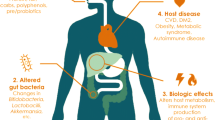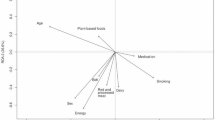Abstract
In attempts to simulate the effects of diet on human breast cancer development groups of female C3H mice infected with mammary tumor virus (MMTV-) were maintained on diets formulated to resemble the typical American, Bulgarian, and Japanese human diets. The incidence of mammary tumors was the highest (84%) in group of mice receiving the simulated meat- and fat-rich American diet, which was also low in selenium (Se content: 0.15 ppm). The appearance of mammary tumors was delayed in the mice maintained on the simulated Bulgarian diet, and the final tumor incidence (27%) paralleled the correspondingly lower Bulgarian breast cancer incidence. The simulated Bulgarian diet contained more Se (0.25 ppm), and was lower in fat, meat, and sugar and higher in complex carbohydrates (cereals) than the simulated American diet. In the mice fed the simulated Japanese diet, the appearance of mammary tumors was also delayed, and the tumor incidence was diminished to 47%. In this diet, fish meal was a major source of Se, which is known to have low bioavailability. Additional supplementation of the Japanese-type diet with bioavailable Se (1 ppm) lowered the tumor incidence to 10%. Based on these studies, recommendations are made for breast cancer risk reduction by dietary means.
Similar content being viewed by others
References
A. Tannenbaum,Am. J. Cancer 38, 335 (1940).
A. Tannenbaum,Cancer Res. 2, 460 (1942).
A. Tannenbaum and H. Silverstone,Cancer Res. 9, 724 (1949).
A. Tannenbaum,Cancer Res. 2, 468 (1942).
K. K. Carroll and H. T. Khor,Prog. Biochem. Pharmacol. 10, 308 (1975).
G. D. Hopkins and K. K. Carroll,J. Natl. Canc. Inst. 63, 1009 (1979).
S. H. Waxler, G. Becher, and S. L. Beal,Proc. Soc. Exp. Biol. Med. 162, 365 (1979).
A. E. Rogers and W. C. Wetsel,Cancer Res. 41, 3735 (1981).
S. K. Hoehn and K. K. Carroll,Nutr. Cancer 1, 27 (1979).
B. S. Reddy, T. Narisawa, and J. H. Weisburger,J. Natl. Cancer Inst. 57, 567 (1976).
D. S. Gridley, J. D. Kettering, J. M. Slater, and R. L. Nutter,Cancer Lett. 19, 133 (1983).
G. N. Schrauzer,Adv. in Nutr. Res., (H. H. Draper, ed., Plenum, New York, 1979, vol. 2, 219–244, and references therein.)
G. N. Schrauzer and D. Ishmael,Ann. Clin. Lab. Sci. 4, 441 (1974).
G. N. Schrauzer, J. E. McGinness, and K. Kuehn,Carcinogenesis 1, 199 (1980).
D. Medina and F. Shepherd,Canc. Lett. 8, 241 (1980).
G. N. Schrauzer, D. A. White, and C. J. Schneider,Bioinorg. Chem. 6, 265 (1976).
G. N. Schrauzer, D. A. White, and C. J. Schneider,Bioinorg. Chem. 7, 35 (1977).
J. H. Lubin, P. E. Burns, W. J. Blot, R. G. Ziegler, A. W. Lees, and J. F. Fraumeni,Int. J. Cancer 28, 685 (1981).
G. N. Schrauzer,Med. Hypoth. 2, 39 (1976).
Food balance Sheets 1964–66, Food and Agriculture Organization of the United Nations, Rome, 1971.
M. J. Lyons and D. H. Moore,Nature (London),194, 1141 (1962).
G. Seman, H. S. Gallagher, J. M. Lukeman, and L. Dmochowski,Cancer 28, 1431 (1971).
R. Mesa-Tejada, and S. Spiegelman,Ann. Clin. Lab. Science 9, 202 (1979).
D. W. Siemann,Rodent Tumor Models in Exp. Cancer Therapy, R. F. Kallman, ed., Pergamon, New York, 1987, pp. 12–15.
A. H. Cantor, P. D. Moorhead, and M. A. Musser,Selenium in Biology and Medicine, J. Spallholz, J. L. Martin, and H. E. Ganther, eds., Avi Publishing Co., Westport CT, 1981, pp. 192–202.
G. N. Schrauzer, K. Kuehn, and D. Hamm,Biol. Trace Elem. Res. 3, 185 (1981).
W. J. Pories, W. D. DeWys, A. M. Flynn, E. G. Mansour, and W. H. Strain,Adv. Exp. Med. Biol. 91, 243 (1978).
G. N. Schrauzer, D. A. White, and C. J. Schneider,Bioinorg. Chem. 8, 387 (1978).
G. N. Schrauzer and D. A. White,Bioinorg. Chem. 8, 303 (1978).
Author information
Authors and Affiliations
Rights and permissions
About this article
Cite this article
Schrauzer, G.N., Molenaar, T., Kuehn, K. et al. Effect of simulated American, Bulgarian, and Japanese human diets and of selenium supplementation on the incidence of virally induced mammary tumors in female mice. Biol Trace Elem Res 20, 169–178 (1989). https://doi.org/10.1007/BF02919109
Received:
Accepted:
Issue Date:
DOI: https://doi.org/10.1007/BF02919109




